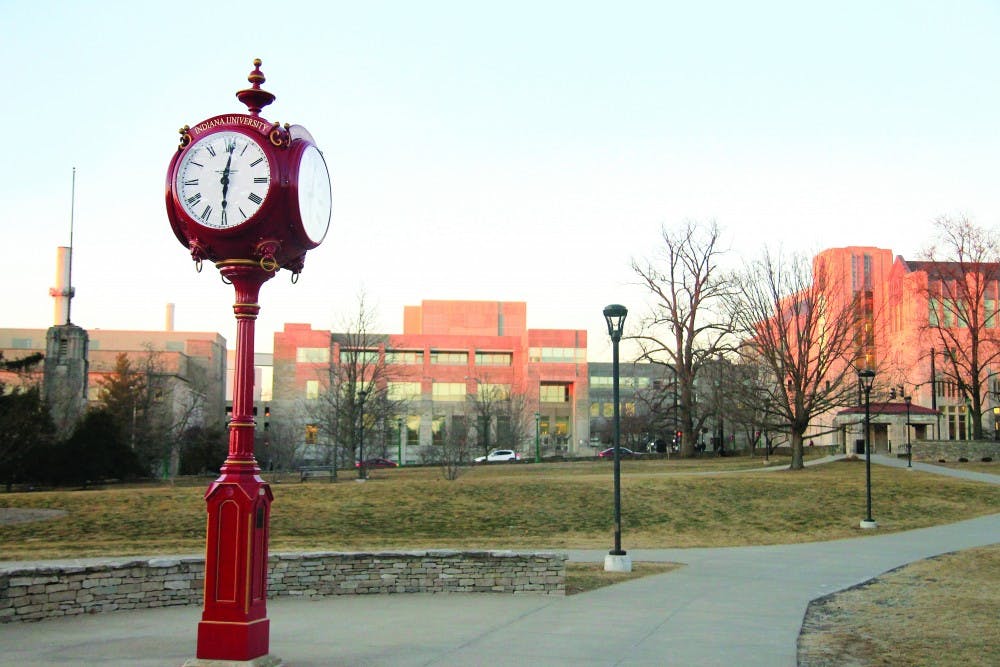For the past 34 years, the Jesse H. and Beulah Chanley Cox Arboretum has provided a natural, vibrant landscape for IU faculty, students and Bloomington residents to enjoy on campus.
Located at the corner of 10th Street and Fee Lane, the Arboretum’s foliage is a welcome burst of color for those crossing campus. The Arboretum is bordered on its north side by 10th Street, while the Herman B Wells Library is on the Arboretum’s east side and the School of Public Health is on its southwesten edge.
A gazebo, pond, river, walking paths, a small waterfall and statues of Adam and Eve join the numerous plants and trees housed within the 11-acre arboretum.
It wasn’t always this way.
Just 37 years ago, the old Memorial Stadium, then known as Tenth Street Stadium, was located where the Arboretum now exists. The stadium was home to the annual Little 500 bicycle race, along with fireworks on the Fourth of July.
The two environments couldn’t have been more different.
Currently, both native and non-native fauna are prevalent in the area.
Designed by the Osborne Engineering Company and constructed at a cost of $250,000 from 1923 to 1925, the stadium was also the home of the IU football team from 1925 to 1959.
The Hoosiers compiled a record of 119-163-22 at the 22,000-person capacity stadium. IU’s final game at the stadium, a 10-7 loss to Purdue, was played in front of 35,325 fans.
Near the end of its existence, the stadium was featured in the 1979 movie “Breaking Away” as the site of the Little 500 race.
After the new Memorial Stadium was built for football in 1960 and Bill Armstrong Stadium was built for soccer and the Little 500 race in 1981, there was no longer a purpose for Tenth Street Stadium.
The decision was made to create an arboretum on the available land where the stadium was.
Indianapolis landscape architect Frits Loonsten, who was first hired by IU in 1940, designed the Arboretum.
Prior to his death in 1989, Loonsten spoke to reporters about the arboretum.
“I really think we don’t introduce our children enough to nature,” Loonsten said.
Loonsten’s design allowed for a natural setting in the middle of IU’s bustling campus. This includes Hemlock Hill, the primary point of reference and the highest point inside the arboretum.
The number and diversity of plants found in the arboretum, identifiable by placards near them, IU has allowed to receive national recognition.
“IU Bloomington has been named a Tree Campus USA every year from 2008-2016,” said Beth Feickert, Capital Planning Project Specialist at the Office of the Vice President for Capital Planning and Facilities.
Regarding IU’s current designation as a Tree Campus USA, Feickert said the awards are presented in late spring for the previous year. This means IU will learn later this year if it has been named a Tree Campus USA for a 10th straight year.
To be designated as a Tree Campus USA, a university must have a campus tree advisory committee, a campus tree care plan, a campus tree program with dedicated annual expenditures and service learning opportunities related to urban forest management.
While these designations are new for IU, the recognition for the beauty of its campus is not.
During his 1918 IU commencement speech, former U.S. President Theodore Roosevelt referenced the forests he encountered while at IU.
“I shall always keep in mind this scene here in the open by the University buildings,” Roosevelt said. “Here under these great trees, these maples and beeches. It is a sight I shall never forget.”



![Dean_Reingold_ltr[52] (1).jpg](https://snworksceo.imgix.net/ids/25483b05-dabd-4378-92bd-70a32c2579f0.sized-1000x1000.jpg?w=1500&ar=16%3A9&fit=crop&crop=faces&facepad=3&auto=format)
